Dreamy windows in the real retail world
Whenever I’d walk by Firma or AC+632 in Greenbelt, I’d always be stopped in my tracks by the window displays, which could be as sumptuous as a Marie Antoinette banquet, as exotic as an Oriental fantasy or as surreal as a Dali painting.
The sheer force of creativity and imagination behind them — conjured up and materialized by owners Ricky Toledo and Chito Vijandre — would inevitably lead me into the store, a treasure trove where I’d always manage to find an accessory or trinket I loved (despite their beauty, much of the merchandise was very reasonably priced).
By nature window displays are fleeting, but the Vibal Foundation has managed to immortalize Vijandre and Toledo’s fantastical tableaus in The Art of Window, Display & Design, a coffee-table book they’re launching under the Fifty Shades of Philippine Art imprint on February 19.

We spoke to the authors about their upcoming tome:
What inspired you to do this book?
CHITO VIJANDRE: Windows are ephemeral; there was a need to document it. We also wanted to share what we learned in making these windows.
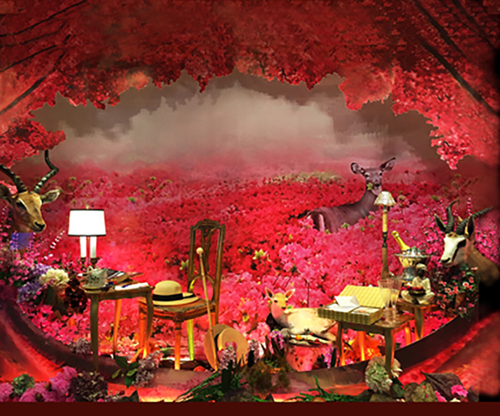
Photo by Ricky Toledo
RICKY TOLEDO: There was a need to do a book like this because none really exists like it. The books in the market are usually just catalogues of store window display photos. Ours goes through the process of creating them, from inspirations to historical, art, and cultural references and even goes on trips to the places that inspired it, dissecting the elements of design and encouraging the reader to explore further by visiting related establishments and reading books that go deeper into the subjects and ideas tackled in each chapter.
CV: With the lockdown, there was also a lot of time to finally work on the book, which we wanted to do for the longest time.
What can we pick up from the book?
CV: Design tips.

RT: Travel, art, historical and cultural references of design.
How did you guys start your business?
CV: We started with Juno, a by-appointment boutique with our finds from travels and some things which we made, like couture pillows and ostrich egg lamps.
RT: We also had friends who made their own jewelry, fashion accessories, and furniture that you normally don’t find in the existing stores, so these were added to the mix.
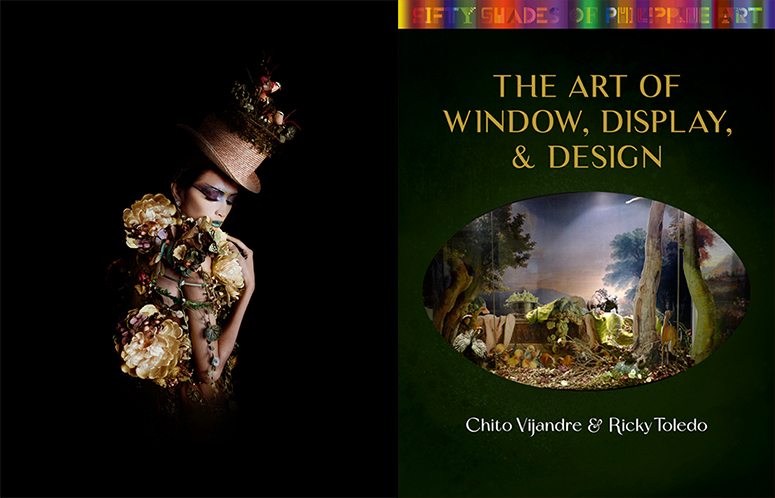
CV: Then we got a lot of publicity and an expanding client list that we could no longer manage in a small space, so we decided to open Firma and later, AC+632.
How did each of you develop your eye for beautiful things and how to put them together?
CV: Family upbringing, I guess. My mother was very artistic in decorating the house, throwing parties. She would even have pagodas constructed in the garden for Oriental-themed celebrations and of course, have the corresponding outfits made by her couturiers.
In grade school I was in art club and I would always win in art contests, eventually being sent as the Philippine representative to the Mexico Olympics, where I painted murals in an art village together with children from all over the world. Later, in my teens, I was drawn to the work of couturiers and how they put designs together, so I enrolled at Slim’s, where I developed the craft further. I would always be attracted to interior design, however — how things were put together in a three-dimensional space — so I would experiment in fixing my home and eventually this would be my next occupation after many years in fashion.
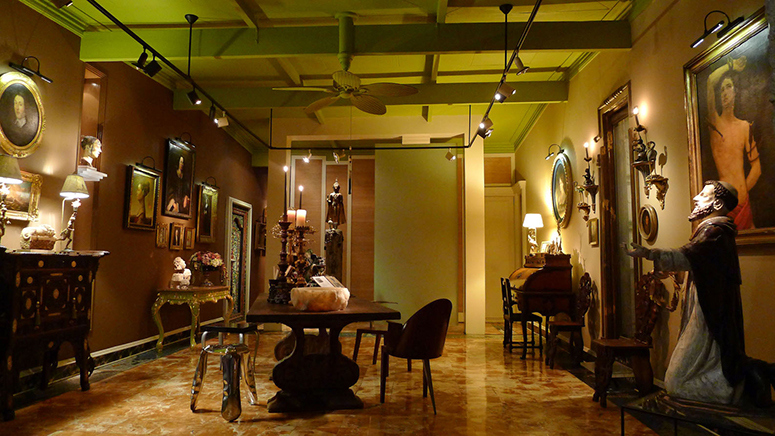
RT: My father was the consulting architect for the government, designing many of the pre-war buildings like the Legislative and Agriculture and Commerce buildings (now the National Museum of Fine Arts and Museum of Natural History, respectively) in a neoclassical style, which influenced my aesthetics when I was growing up. I was also fascinated with my mother’s dresses, many of her own design, since she had studied fashion design when she was still single.
In school, I was drawn to art history and the humanities as subjects in my interdisciplinary course in college. I would eventually get a job with an Italian design and publishing firm and spend part of the year in Europe, where I immersed myself in the visual arts at galleries and museums, aside from learning from the graphic and interior designers in our firm.

If you had to pick your best windows, what would they be, and why?
CV: “Conjuring Dreams of Africa,” because of the way the whole tableau came together splendidly — the color scheme and how the romance of Isak Dinesen was captured.
RT: “Once Upon A Dream” because the fantasy appealed to all ages, how the fairytale king Ludwig could have such a wild imagination and create those outrageous castles.
How did you two meet and when did you realize you were destined to become life partners?
RT: We met at a German halogen lighting shop, which was one of the few specialist shops in the ’80s when there was not much choice for illuminating spaces.
CV: Whoever was just as anal about lighting had to be a good choice for a partner. LOL
RT: Exactly, it was destiny. We dated after that and when I saw what he did with the lighting in his home and how we loved the same things —not to mention that he threw the most fun parties with the craziest friends — our fate was sealed. LOL
How would each of you describe your style or aesthetic in three words?
CV: Maximalist. Colorist. Iconoclastic.
RT: Cross-cultural. Neoclassic. Conceptual.
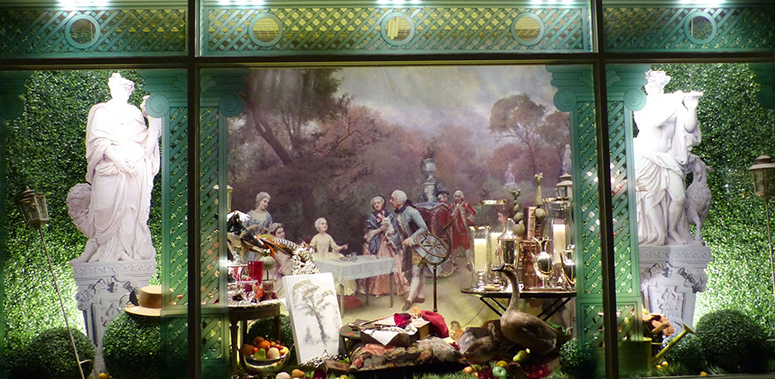
What was the first trip you took together: where did you go and what souvenirs did you bring home?
RT: Hong Kong. Since you mentioned souvenirs, there’s a funny story about that trip. It was our last day and we were rabidly shopping, planning to have a very late lunch, but forgot that our former yaya, who was already working in Hong Kong, had invited us to Aberdeen for a cruise and early dinner. She offered us drinks, which we overindulged in on an empty stomach, making the rest of the trip one big hazy memory that yaya just had to reconstruct for us when we woke up in the hotel the next morning with shopping bags of tourist tat that we never, in our sober moments, even give a second glance to. She said we were so “gone” that she had to constantly guide us till we were tucked safely in bed.
CV: So those souvenirs we definitely can’t be proud of. But we did find a nice pair of Ming figurines on Hollywood Road, which we still keep today. And Ricky had secretly bought a Lalique classical figure of dancing nymphs, which he gave me on my birthday, also treasured through the years.
How often did you use to travel a year?
When we first opened Firma in Greenbelt, we were in Europe twice a year for the houseware, fashion and jewelry design shows, but recently we just go once a year for the shows and for holiday as well, trying to discover a new destination each time when we also search for new artisans and go antiquing. We also do about four trips around Asia to discover new things.
What have been your most epic, unforgettable trips thus far?
CV: Andalucia. It was a visual, cultural and culinary extravaganza, from the Mezquita in Cordoba to the Alhambra in Granada and the Cathedral and houses of Seville.
RT: It was also our chance to enjoy flamenco, which we love — from the caves in Granada to the bodegas in Seville. Our Byzantine trail was also quite memorable, tracing bastions of Byzantine art and architecture from Istanbul to Venice and Sicily. Italy is always one of our favorites, not to mention that we have friends and family there. But Turkey is also close to our hearts.
CV: OMG, the food and the Grand Bazaar, it’s a shopaholic’s nightmare getting to see and buy everything in sight.
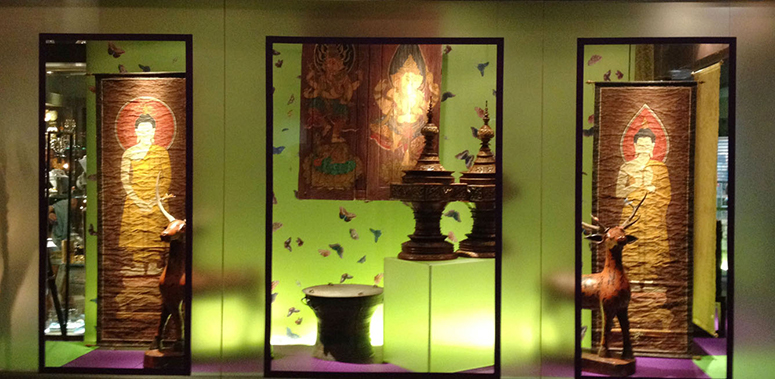
How do you go about creating a window — what role does each play in the creative process — and how do you know when it’s done?
CV: Depends on the merchandise. We look for a theme, personality or story then do a lot of research from books, Ricky’s photos from our travels and also online.
RT: One time, there was no merchandise at all. We were fascinated by René Gruau’s fashion illustrations and wanted to use one of them, so we made up a story about a countess who had a secret life as a striptease artist in a Parisian club, where she was known as Mademoiselle Gruau.
CV: Using one of Gruau’s blown-up figures, I made a black feather cubby coat for Mlle. Gruau, who was performing on a stage with purple velvet curtains and neon green walls, encircled by a gold doily halo while a silhouetted audience of gentlemen in top hats cheered on. Her pet baby alligator was on a leash nearby.
RT: Chito does the actual dressing up of the window and positioning the objects we agree upon.
CV: I have to consult Ricky on how it looks graphically since I can have a tendency to overdo things. LOL
We consider the window done when we’ve exhausted all the possibilities in terms of images and objects to be featured, experimenting with what works best.
RT: But many times, just when we agree that it’s done and I leave, Chito adds another object. Or another unexpected twist, which changes everything altogether.
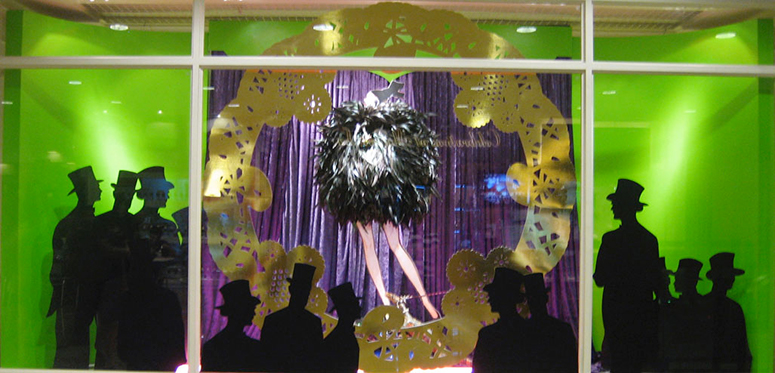
Who are your favorite, most influential window dressers, and what lessons/inspirations do you take away from them?
CV: The windows of Leïla Menchari for Hermès on Rue Fauborg Saint-Honore in Paris until her retirement in 2013. They were so magical; she truly deserves the title “The Queen of Enchantment.” There were so many details and narratives going on — a maximalist’s dream. With her windows, “More is truly more.”
RT: The windows of Fortnum & Mason in London. They’re always witty but classic, showcasing the merchandise but always in a way that captures your imagination with its visual opulence and engaging stories.
During the lockdown, did you make any changes to your home to adapt to the circumstances?
RT: How could you not? It’s what you see 24/7. LOL
CV: We redecorated, moved furniture and accessories around.
RT: I actually had to keep reshooting the interiors of the house for the book because things kept changing all the time.
What design tips can you give our readers adapting to this new normal?
CV: Do massive editing, get rid of junk and get new things to change the energy.
RT: Change the look and brighten up your mood by reupholstering sofas and chairs and repainting walls with colors that make you happy.
* * *
The Art of Window, Display & Design will be available at AC+632 in Greenbelt 5 and bookstores around the end of March.
Banner photo: The 2009 Christmas window of AC+632, “Once Upon A Dream,” was inspired by the Fairy Tale King, Ludwig II of Bavaria. The tableau features an imagined fantasy of the king, who from his Gothic bedroom in Neuschwanstein Castle daydreams of his sleigh pulled to the heavens by dolphins and the winds of Zephyr and Aura as his idol, the Sun King Louis XIV, gives his blessing as personified by the rising moon. Photo by Patrick Uy


